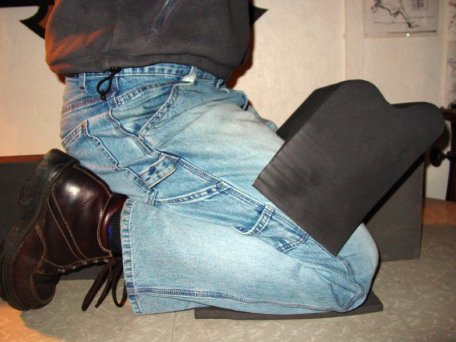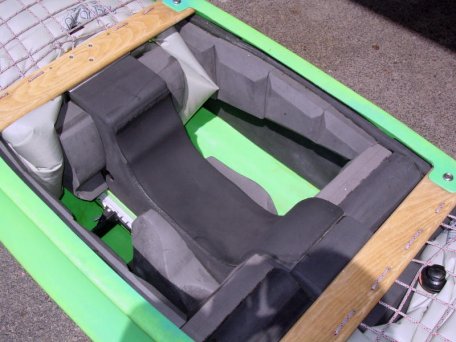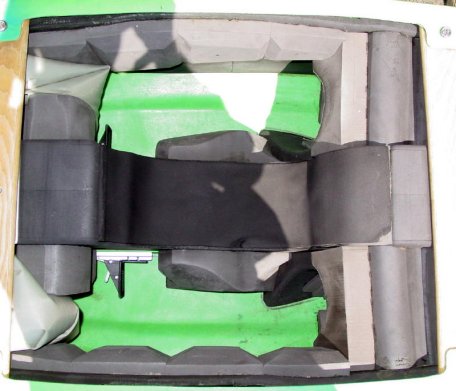Foam Bulkhead Outfitting
Posted: Sun Mar 19, 2006 7:48 pm
from http://kayakoutfitting.com/tips/wwcanoe/index.html
Outfitting (make that Infitting) your whitewater canoe
Do you enjoy whitewater canoeing but don't appreciate all the excess H2O when creeking or playing? Would you prefer to avoid a system with straps, d-rings or patches? Do you have a new canoe that comes with a full length saddle and foam components and want to know how to put it all together? If you answered "yes" to any of these questions then this information may be helpful to you!
Boats availible from Esquif, Robson, Pyranha, and Savage have utilized a full length saddle/thighook system since their inception. The origin of this system goes back to steep creekers like David "pyscho" Simpson, and is used by 2 time world rodeo champion Eli Helbert.
For rodeo and creeking this system is ideal as it maximizes control, is easy to jump in and out of (ingress/egress) and provides additional bouancy and stability when full of water. This system may be applied to ABS hulls as well. If you tend to play hard and paddle where there are bigger drops, holes and less places to empty then this information may be helpful to you.
WARNING; Whitewater paddling is an extremely dangerous activity. Some of the information given can "increase" the difficulty to exit your boat. Never count on your roll, and always make sure you can get out of your boat in the event of an emergency. Enjoy and paddle safely.
For starters you will need minicel foam. Kayakoutfitting.com has many sizes and styles of foam to choose from.
For cutting minicel a bandsaw is ideal, but a hacksaw blade, or small saw will work in it's place. To shape minicel a sureform or dragonskin works very well. Various grades of sandpaper can be used to smoothly finish things off.
Putting it all together requires contact cement or adhesive backed velcro. PVC tubing of 1-1/2" should be used to make the transfer tubes. These items are availible at most hardware or homesupply stores.
Lastly...."patience". Hurrying the process typically results in pieces that fit you and the boat incorrectly. Take your time and reap the rewards, and enjoy.
Tear Down-- First you'll need to take that brand new boat apart. Untie the airbags and lacing, remove the thwarts, saddle and thighooks.
Knee Pads--before you can do anything else determine the thickness of your desired kneepads. Have the pieces to use in your boat loosely to determine saddle height and thighook placement. I would recommend going at least 1/2" for comfort. Velcro works well here because eventually mincel crushes and needs replacement and tearing it off and adding a new piece can be done more easily.
Saddle--Choosing your saddle height and cut is crucial in my opinon. I would recommend a saddle that is high enough to afford comfort, but low enough to maintain a good center of gravity. (I am 5'-10" tall with a 31" inseam and prefer my saddle height between 8-3/4"-9". ) Note** "everyone" has different leg dimensions... hips to knee's, knee's to ankles, etc. Be extremely choosy here!, you can always remove foam but adding it back on isn't much fun. Level front to back isn't necessary either. A little less under your butt is ergonomically correct. Adding a piece between your lower back/butt and the saddle also helps to raise the bow with a good lean back.
Center your saddle/thighook combo in the water with someone to tell you when your trim is correct. Bow forward= wet but easier initaition on moves when playing. Centered= "ideal" for general paddling in most situations. Bow light= not good... don't ever go past center.
On Pyranha and Savage boats make sure you glue the plastic plates to the saddle that the pegs mount to. If you do not they will tear the saddle in time.
One drawback to a full length saddle is that the water doesn't always transfer evenly from side to side. Using a few pieces of PVC tubing pushed through the saddle resolves this problem. Simply push the tubing through the saddle 3" up from the bottom in a twisting motion, remove the foam plug, and cut it off flush. It is advisable to do this in three locations--ahead of the knees, under your crotch, and above the feet. DO NOT cut foam from beneath the saddle as this is a crucial contact area with the hull and a suseptible place to break the foam saddle.
Thighooks/Bulkhead--This is the "key" to the system. If placed correctly you will be stable, in control, and locked in while vertical or upsidedown. If placed incorrectly you will not be "attached" to the hull, and have a harder time rolling or using the boats designed abilities.
To determine the best placement for your thighooks here are some important things to consider. How tight do I want to be? Will I want the fit to be tighter later? Will I be able to get in and out with ease?
For a snug fit use these guidelines. Once you have determined the size/thickness of your kneepads and saddle height you can now determine the proper placement of the thighooks. Ignoring the lower cut from the factory set the angle so the inside top of the hooks are on top of your thighs snugly. (I prefer the hooks to be closer to my crotch than knees, and you can always add pieces to the front or back of them if you want more coverage.) Mark the blocks on the saddle and sidewalls with a marker. Glue the thighooks to the saddle first, outside of the boat, before installing the saddle/thighook combo. Glue the saddle and thighooks to the hull, making sure all of your marks are lined up. Glue or velcro the outer thighooks to the sidewall foam. (Tip trick; use two pieces of wood cut 2" longer than your thwarts to open up the hull before gluing the outer thighooks, when you are ready to attach the outer sides remove the wood. This will give you the room you need to work.)
For a looser fit put less coverage on your upper thigh with the hooks. You can always glue pieces of minicel to the inside of them to tighten yourself up as you become more comfortable with the boat, and the confidence in your roll.
Proper knee block alignment. Notice the angle on the top of the leg, this gives you a "tighter" fit.
Adding On-- For maximum displacement and retention you may want to "add-on". (Reminder- adding foam in specific areas can increase the difficulty to exit your boat in "any" situation.)
Sidewalls-- Although Robson, Pyranha and Savage boats come with sidewall foam oftentimes a little more is better. Adding 1-1/2" thick pieces is simple and should not inhibit entry/exit. Sitting inside the boat find the line where your body does not contact the sidewalls and draw a line. Using heavy construction paper or cardboard make a pattern to replicate on your foam block. Cut the foam in one whole 3" thick piece. You should have more foam at the rear of the sidewall than the front. (About 30 degrees give or take.) Cut the piece in half down the middle. Glue or velcro to the existing sidewall foam. You may find it better to taper the piece deeper in the rear than the front, as not to inhibit your legs near the thighooks.
For boats that don't have sidewall foam, a molding gauge works well for getting the contour of the inside of the hull. You can replicate the shape on your foam pieces, then cut and attach (a bandsaw is ideal for this).
Saddle-- You can add foam that will aid in displacement in three areas of your saddle. The first area is what has been cut away by the maufacturer where you aren't sitting on top of the saddle. Cut pieces for the front and rear of where you sit, so that you fit snugly but can still get in and out or roll without hitting them. The second is a void area between the thighook/bulkhead area and where your feet are along the bottom of the saddle. Adding pieces here helps displace water to the outer/lower edges of the hull. Make sure "not" to inhibit the area where your feet/ankles are. Lastly is the area above the footpegs and behind your butt. Adding pieces to both sides in this area will move the water more to the center and outer edges. Note** Be "sure" to leave room to adjust your footpegs and allow for entry/exit without trapping your feet or legs.



 [/b]
[/b]